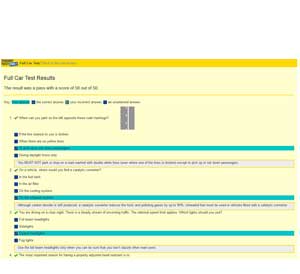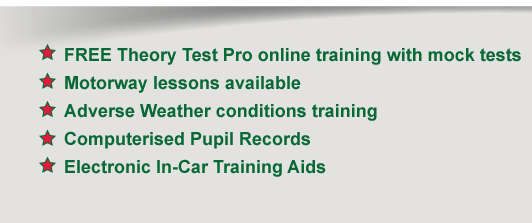
The Theory Driving Test

Theory Test Pro
At LeaP we like to help you practise for your theory test by providing you full access to Theory Test Pro free of charge.
What is Theory Test Pro?
Theory Test Pro is a highly realistic online simulation of the UK's driving theory test. It contains the entire official test questions licensed from the DVSA, the people who set the tests.
It allows you to practice for your theory driving test from the comfort of your own home at any time of the day or night.
You could also practice for the hazard perception part of the test with the online test video clips.
How do I use Theory Test Pro?
Your instructor will provide you with full log in details, this service is provided Free of Charge to all LeaP-SOM students.
To access Theory Test Pro, please click the banner above.
1. Overview
If you want to drive a car or ride a motorcycle you’ll need to pass the driving theory test before booking either the car practical driving test or the motorcycle practical test.
There are 2 parts to the theory test:
- the multiple choice part
- the hazard perception part
Both parts of the test are taken on the same day. You must book your driving theory test in advance. The questions in the multiple-choice part and format of the hazard perception part depend on what kind of vehicle you want to drive.
You need to pass both to pass the theory test.
You can take the shorter ‘abridged’ car theory test if you’ve got the Safe Road User Award.
The theory test pass certificate You’ll then get a theory test pass certificate. You’ll need the certificate number when you book your practical test.
Preparing for the test There are official publications and tools to help you prepare for the test, and if you’ve got special needs then there are a number of facilities to help. You Can find a free online copy of the Highway code here.
2. Who needs to take the test
Great Britain licence holders You usually need to take the theory test before you can get your first full car or motorcycle driving licence.
There are 2 exceptions
- You don’t need to take the car theory test if you hold a B1 licence (3 or 4-wheeled light vehicle).
- If you hold a full moped licence issued after 1 July 1996 following a test you don’t need to take the motorcycle theory test.
Adding new categories to your licence You’ll need to take another theory test if you want a licence for a new category of vehicle.
For example, if you have a car licence and you want a motorcycle licence you’ll need to take the motorcycle theory test before taking the motorcycle practical test.
You won’t normally need to take a theory test if you want to upgrade within a vehicle category.
For example, if you have a full automatic car licence and you want a manual car licence you won’t have to take a theory test.
You must make sure you have the right licence. Contact the Driving Standards Agency (DSA) if you’re not sure if you need to take a theory test.
Non Great Britain licence holders If you don’t have a Great Britain (GB) licence you might still be able to drive in GB without taking a driving test.
Find out if you can drive in GB with your non-GB licence.
You don’t need a driving licence for electric bikes, mobility scooters or powered wheelchairs.
3. How the theory test works
The theory test is made up of a multiple-choice part and a hazard perception part. You need to pass both parts to pass the theory test.
If you pass 1 part and fail the other you’ll fail the whole test, and you’ll need to take both parts again.
The questions in the multiple-choice test will depend on the category of vehicle you are hoping to get a licence for. For example, a motorcycle theory test will contain questions that don’t appear in any other test.
For the hazard perception test there are no separate versions for different vehicles, but the pass mark is different for them.
At the theory test centre
You aren’t allowed to take any personal items into the test room with you. All your personal items must be stored in the lockers provided.
If you’re found with any prohibited items in the testing room your test will be stopped, you’ll be asked to leave and you’ll lose your test fee.
Once you’re in the test room you aren’t allowed to talk to or distract other candidates.
The multiple-choice part
Before the test starts you’ll be given instructions on how it works.
You can choose to do a practice session of multiple-choice questions to get used to the layout of the test. At the end of the practice session the real test will begin.
A question and several possible answers will appear on a computer screen - you have to select the correct answer. Some questions may need more than one answer.
You can move between questions and ‘flag’ questions that you want to come back to later in the test.
Some car and motorcycle questions will be given as a case study. The case study will:
- show a short story that 5 questions will be based on
- focus on real life examples and experiences you could come across when you’re driving
The car and motorcycle multiple-choice part lasts for 57 minutes and the pass mark is 43 out of 50.
After the multiple-choice part you can choose to have a break of up to 3 minutes before the hazard perception part starts.
The hazard perception part
Before you start the hazard perception part, you’ll be shown a short video clip about how it works.
You’ll then be shown a series of 14 video clips on a computer screen. The clips:
- feature everyday road scenes
- contain at least one ‘developing hazard’ - but one of the clips will feature 2 ‘developing hazards’
A developing hazard is something that may result in you having to take some action, such as changing speed or direction.
Hazard perception test scoring
The earlier you notice a developing hazard and make a response, the higher you will score.
The most you can score for each developing hazard is 5 points.
To get a high score you need to respond to the developing hazard as soon as you see it starting.
If you click continuously or in a pattern during a clip a message will appear at the end. It will tell you that you have scored zero for that particular clip.
You won’t be able to review your answers.
The pass mark for cars and motorcycles is 44 out of 75.
Your test result
You will be given the results of your theory tests at the test centre after taking it.
You’ll get a pass certificate if you pass your theory test. You’ll need this when you book and take your practical test.
Your theory test pass certificate lasts for 2 years after taking your test. You’ll need to take and pass the theory test again if you haven’t passed your practical test by then.
4. Preparing for the theory test
Tools and information are available to help you practice and prepare for both parts of the theory test.
Preparing for the multiple-choice part
To prepare for the multiple-choice part of the theory test you should use 3 books known as the ‘source material’. They are:
- The Highway Code
- ‘Know your traffic signs’
- the relevant book from the ‘essential skills’ range
You can buy all the publications from most high street book shops and download the ‘Know your traffic signs’ booklet.
Online practice theory test
You can take a practice theory test online. It only includes multiple choice questions and does not include the hazard perception part.
Preparing for the hazard perception part
‘The official guide to hazard perception’ is a comprehensive training DVD. It’s available from most high street book shops. You can also order it from The Stationery Office.
5. Documents you need to take to your theory test
You need to bring both parts of your driving licence - the photocard and the paper counterpart.
If you have an old-style paper licence, you must take your signed driving licence and a valid passport. No other form of photographic identification will be accepted.
If you don’t have one, you must get a passport or update your paper licence to a photocard licence.
Your test won’t go ahead and you’ll lose your fee if you don’t bring the right documents to your test.
If you’ve lost your driving licence
If you lose your driving licence, you must apply for a replacement. This could take up to 15 days. If this happens, you may have to rearrange your test.
Cancelled tests
You might be able to apply for a refund of out-of-pocket expenses if the Driving Standard Agency (DSA) cancels your test at short notice.
Content supplied by www.gov.uk/browse/driving/learning-to-drive








